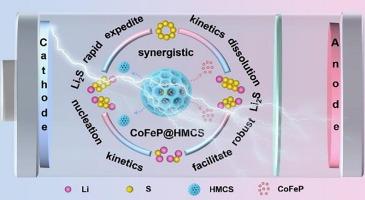Spatial carbon channel with confined ultrafine nano-phosphides for boosted reversible sulfur redox in lithium-sulfur batteries
IF 14.9
1区 化学
Q1 Energy
引用次数: 0
Abstract
Sluggish kinetics coupled with parasitic shuttling reactions are pivotal challenges hindering the performance of lithium-sulfur (Li-S) batteries. Improving areal capacity and cyclability of Li-S batteries can be achieved by addressing these challenges. A composite sulfur host material is synthesized herein by in situ anchoring ultrafine cobalt-iron phosphide nanoparticles (5–7 nm) onto a hollow mesoporous carbon sphere (HMCS) framework. This strategy achieved exceptional spatial restriction and a high density of catalytically active sites through the encapsulation of sulfur within a hollow-structured framework. Specifically, HMCS expedites rapid Li2S nucleation kinetics, while CoFeP facilitates robust Li2S dissolution kinetics by mitigating decomposition barriers. This synergistic integration equips CoFeP@HMCS with robust bi-directional catalytic activity, significantly promoting interfacial charge-transfer, facilitate sulfur multistep catalytic conversion, and inhibiting shuttling. Consequently, the battery exhibits excellent rate performance (991 mA h g−1 at 5.0 C) and retains a high areal capacity of 6.06 mA h cm−2 after 200 cycles under a high areal sulfur loading of 8.2 mg cm−2 but a low electrolyte/sulfur ratio of 4.8 μL mg−1. This work contributes to enhancing the practical specific capacity of lithium-sulfur batteries and deepens the understanding of catalysts enabling bidirectional electrocatalytic sulfur conversion.

超细纳米磷化物空间碳通道促进锂硫电池可逆硫氧化还原
缓慢的动力学加上寄生穿梭反应是阻碍锂硫电池性能的关键挑战。通过解决这些挑战,可以提高锂电池的面积容量和可循环性。本文通过在中空介孔碳球(HMCS)骨架上原位锚定超细磷化钴铁纳米颗粒(5 - 7nm),合成了一种复合硫宿主材料。这种策略通过在空心结构框架内封装硫,实现了特殊的空间限制和高密度的催化活性位点。具体来说,HMCS加速了Li2S的快速成核动力学,而CoFeP通过减轻分解障碍促进了Li2S的溶解动力学。这种协同整合使CoFeP@HMCS具有强大的双向催化活性,显著促进界面电荷转移,促进硫的多步催化转化,并抑制穿梭。因此,该电池在5.0℃下具有优异的倍率性能(991 mA h g−1),并且在8.2 mg cm−2的高面积硫负荷和4.8 μL mg−1的低电解质/硫比下,在200次循环后仍保持6.06 mA h cm−2的高面积容量。这项工作有助于提高锂硫电池的实际比容量,加深对双向电催化硫转化催化剂的认识。
本文章由计算机程序翻译,如有差异,请以英文原文为准。
求助全文
约1分钟内获得全文
求助全文
来源期刊

Journal of Energy Chemistry
CHEMISTRY, APPLIED-CHEMISTRY, PHYSICAL
CiteScore
19.10
自引率
8.40%
发文量
3631
审稿时长
15 days
期刊介绍:
The Journal of Energy Chemistry, the official publication of Science Press and the Dalian Institute of Chemical Physics, Chinese Academy of Sciences, serves as a platform for reporting creative research and innovative applications in energy chemistry. It mainly reports on creative researches and innovative applications of chemical conversions of fossil energy, carbon dioxide, electrochemical energy and hydrogen energy, as well as the conversions of biomass and solar energy related with chemical issues to promote academic exchanges in the field of energy chemistry and to accelerate the exploration, research and development of energy science and technologies.
This journal focuses on original research papers covering various topics within energy chemistry worldwide, including:
Optimized utilization of fossil energy
Hydrogen energy
Conversion and storage of electrochemical energy
Capture, storage, and chemical conversion of carbon dioxide
Materials and nanotechnologies for energy conversion and storage
Chemistry in biomass conversion
Chemistry in the utilization of solar energy
 求助内容:
求助内容: 应助结果提醒方式:
应助结果提醒方式:


